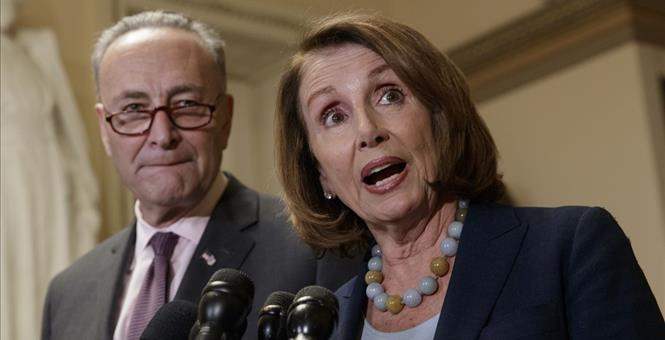After Hillary Clinton’s loss in 2016, you’d think that there would be at least some sense of direction among Democratic Party leaders as to where they should plant their messaging seed for the 2018 midterms. Running on a wave of “inevitability,” or simply hoping your opponent says or does something that turns off voters just isn’t enough.
The Democratic Party is asking followers on social media to vote on a new slogan for the upcoming elections, and the choices, so far, aren’t that great, according to The Atlantic’s Adam Serwer:
https://twitter.com/AdamSerwer/status/882674564316246016
Derek Willis, of ProPublica, points out the worst:
Not exactly the most inspiring political slogan, @dccc: pic.twitter.com/oIE9bTBHa0
— Derek Willis (@derekwillis) July 5, 2017
“Have you seen the other guy?” – That one is just plain lazy. In other words, “vote for us, we’re not as bad.” Hardly a message that motivates people to get in their car and drive to a polling place.
The American Prospect, a liberal publication, sums up the Democratic conundrum as far as trying to formulate a winning message:
Electoral tests of early 2017 have given rise to several schools of thought among Democrats about how to win next year, and beyond. Proponents cite the fragments of evidence at hand—four House special elections, the Virginia primary, even the elections in Britain and France, for their cases. The focus of most of these analyses is on policy: Should candidates run to the Left or to the Center? Many issues are in controversy: single-payer health care (favored by Rob Quist but not by Jon Ossoff), abortion (Omaha Mayoral candidate Heath Mello’s position turned off pro-choice advocates), and pipelines (dividing the Virginia contestants).
One school, relying on Labour’s strong showing under Jeremy Corbyn, argues that a populist politics of the left is Democrats’ formula for winning. But that’s not only an unproven hypothesis, it’s also not been tested in a general election for president since McGovern-Nixon in 1972.
The ideal policy posture is an unknown. However, there are enough “known knowns” to sketch the path to a win.
Some Democrats are complaining that it’s hard to build a national message with someone like Nancy Pelosi at the helm, according to The Atlantic:
“The national brand is toxic,” said Democratic Representative Tim Ryan of Ohio, who unsuccessfully challenged Pelosi for the title of House minority leader last year, in an interview. “There’s just no doubt about it. We are not connecting with people the way we need to connect with them.”
On the campaign trail, Democrats worked to distance themselves from the national party. In Montana, Democratic candidate Rob Quist reportedly didn’t want Democratic National Committee Chair Tom Perez to campaign with him, though Perez did campaign for Democratic candidates Jon Ossoff in Georgia and Archie Parnell in South Carolina. Quist instead promised that he would be “an independent voice” in Washington, while in Kansas, Democratic candidate James Thompson argued that “things aren’t working no matter who’s in charge.”
Democrats in conservative parts of the country have long tried to prove they’re not typical Washington liberals. But if candidates feel heightened pressure to separate themselves from the national brand amid public skepticism toward the party, voters may be left wondering what it is they represent.
“I think voters still don’t totally trust Democrats. I think they don’t know necessarily what Democrats stand for, and how they differentiate from Republicans,” Democratic Representative Pramila Jayapal of Washington, who won election in November with the endorsement of Senator Bernie Sanders, said in an interview.
At the moment, being “Against Trump” is good for Democratic fundraising and for keeping the base engaged with the day-to-day fights in Congress and the courts. However, to expand that fervor for 2018, Democrats will need to move past being the party of opposition, and somehow come up with a plan to actually defeat Trump, rather than just oppose him.
“Vote for us, we’re a little better,” isn’t going to cut it.
